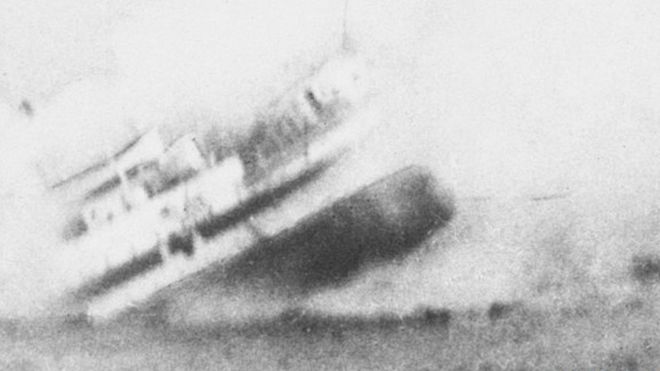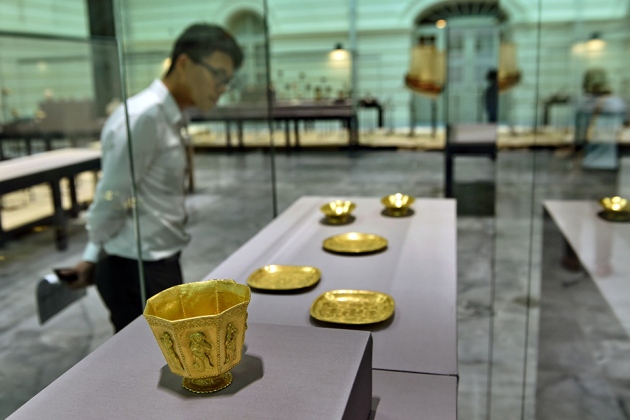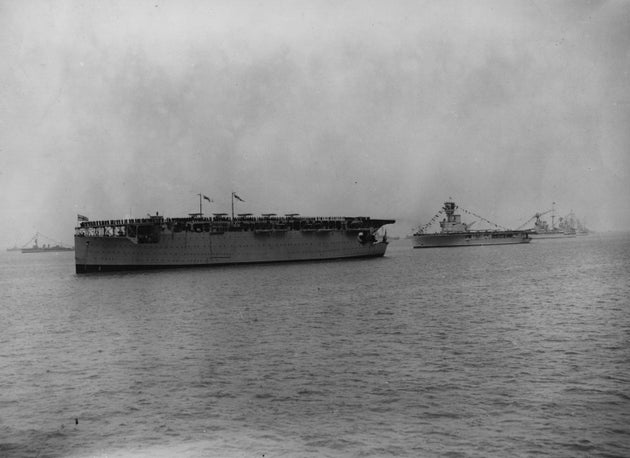HOT NEWS !
Stay informed on the old and most recent significant or spectacular
nautical news and shipwreck discoveries

-
WW1 shipwreck off Folkestone
- On 24/02/2017
- In Parks & Protected Sites
- 0 comments

From BBC News
The remains of a First World War hospital ship that sank in the English Channel more than 100 years ago has been given legal protection.About 160 people died when HMS Anglia struck a German mine close to the Kent coast on 17 November 1915. The ship was carrying soldiers, some severely injured in the Battle of Loos, back from France to England.
Many of the casualties were soldiers with amputated limbs as well as medical staff who perished trying to save them.
Campaigners have long-called for the ship to be protected - to safeguard the remains and honour those who died.
It has now been included in a new list of wrecks covered by the Protection of Military Remains Act. Historian Dr Peter Marsden said it was "wonderful to have succeeded at long last" but he was highly critical of the Ministry of Defence (MoD).
"This huge story lying on the sea bed needs protection.
It shouldn't take years and years to get it done," he said. "It's not just protection of the objects that might be taken by divers, it's the recognition by the government that these are the people who died in service to their country."
An MoD spokesman said: "The Ministry of Defence ensures that all wrecks, including HMHS Anglia, are protected under the Act if they meet the correct criteria."
-
Save WWII shipwreck HMAS Perth from salvagers
- On 11/02/2017
- In World War Wrecks
- 0 comments

By Jewel Topsfield - WA Today
Australia and Indonesia will conduct a joint dive of the World War II shipwreck HMAS Perth off the coast of Java next month amid fears the vessel, which is believed to hold the remains of 40 to 60 men, is being destroyed by illegal salvagers.Efforts to protect the wreck comes as three Japanese ships that sunk off the coast of Borneo during the 1944 Pacific War by US forces have reportedly been torn apart for scrap.
The research dive on HMAS Perth will be the first detailed survey of the wreck since 2014, following the shock discovery the previous year that the cruiser and other WWII wrecks in the vicinity had been looted for scrap metal.
A sonar survey of the HMAS Perth carried out by the Australian National Maritime Museum and the Indonesian National Research Centre of Archaeology in December was inconclusive as poor weather conditions impacted on the quality of the images taken.
The museum's director, Kevin Sumption said the dive would confirm the condition of the wreck, if it had been recently interfered with by salvagers, its corrosion and its historical and archeological significance.
"We are very aware that there are concerns in the community and we are doing everything we can, working in close partnership with our Indonesian partners, to secure formal protection of the site," Mr Sumption said.
-
Une épave de sous-marin allemand
- On 11/02/2017
- In World War Wrecks
- 0 comments

De Mer et Marine
L'U-864 a été coulé le 9 février 1945 par un sous-marin britannique à deux milles de l'île norvégienne de Fedje, non loin de Bergen.Le U-Boot allemand venait d'appareiller avec à son bord 67 tonnes de mercure liquide à destination du Japon.
Depuis 2003 et la découverte, à 160 mètres de fond, de l'épave sectionnée en deux parties, l'administration maritime norvégienne faisait face à un dilemne : le métal toxique à bord s'était déjà répandu sur une surface de 30.000 m2; fallait-il risquer d'en propager davantage en relevant l'épave ?
Et si on la laissait dans le fond, comment faire pour empêcher le mercure de se répandre à chaque tempête? La partie avant, reposant sur le bord d'un fossé sous-marin, était la plus problématique.
L'administration norvégienne a donc choisi d'utiliser une technique d'enrochement, très répandue à l'offshore pour notamment protéger les câbles sous-marins.
Elle a, pour celà, fait appel au spécialiste néerlandais du dragage et des opérations offshore Van Oord.
Les ingénieurs ont élaboré une solution originale: isoler le sol marin contaminé et recouvrir l'épave, le tout en respectant les contraintes de l'administration norvégienne, qui avait fixé à 220 ml (soit un verre) la quantité de mercure qui pouvait être rejetée durant l'ensemble des travaux.
-
Show of shipwrecked treasures raises scientists’ ire
- On 07/02/2017
- In Museum News
- 0 comments

By Tracy Watson - Nature
A museum show of sumptuous treasures from a ninth-century shipwreck is being denounced by researchers, who say that commercial salvage of the artefacts irreversibly damaged the wreck’s scientific value.
On 6 February, the Advisory Council on Underwater Archaeology sent a letter of opposition to the Asia Society, the non-profit group that is mounting the show of Chinese Tang-dynasty porcelains, gold vessels and other objects from the wreck at its New York City museum. Critics fear that the exhibition, slated to open on 7 March, will encourage exploitation of wrecks by for-profit firms.
Museums that show salvaged treasures don’t intend to promote treasure-hunting, “but that’s the effect it has”, says Marco Meniketti, an archaeologist at San José State University in California who leads the advisory council.
Artefacts from the Belitung wreck, named after the Indonesian island close to the ship’s final resting spot, were scheduled to go on display at the Smithsonian Institution's Sackler Gallery in Washington DC in 2012.
The institution cancelled the exhibition in December 2011 after vocal opposition from Smithsonian scientists and others. But the problems presented by exhibiting the spoils of commercial salvage remain, says maritime archaeologist Filipe Castro at Texas A&M University in College Station.
That type of excavation “silences all the questions that a vessel like that could answer”, he says, reeling off a list of data that should have been collected at the Belitung site.
In a statement, the Asia Society said that “American audiences should have an opportunity to see this material because of its significance”. In recognition of “the sensitivities” around the exhibition, the society is co-sponsoring a public symposium about the ethics of archaeology and commercial salvage.
And the head of Seabed Explorations, the company that salvaged the wreck, defended his team’s work. “Without Seabed Explorations there wouldn’t be any data existing at all about the Belitung shipwreck,” says Tilman Walterfang.
-
1,800-year-old shipwreck found
- On 02/02/2017
- In Underwater Archeology
- 0 comments

By Molly Fosco - Seeker
An 1,800-year-old Roman shipwreck was discovered off the coast of Spain's Balearic Islands.Spanish archaeologists found the ship about 230 feet (70 meters) underwater, reported El Pais. According to the Balearics Institute for the Study of Marine Archeology (IBEAM), most of the 1,000 - 2,000 Ancient Roman jars onboard are still in their original position from the time of the ship's sinking.
The jars, known as amphorae, have remained untouched for nearly two millennia. The amphorae are made of clay and were likely carrying garum, a pungent, fermented fish sauce that was considered a delicacy in Roman society, IBEAM's scientific director explained.
Factories in Spain and Portugal once mass produced garum because it was such a widely used condiment, much as ketchup is today.
This is one of the few intact shipwrecks that has ever been discovered in the western Mediterranean.
"As far as we know, this is the first time that a completely unaltered wreck has been found in Spanish waters," Javier Rodríguez, one of the marine archaeologists who participated in the exploration, told El Pais.
The fact that the ship was found in national park waters was a key factor in its preservation. The Balearic Islands foster hundreds of animal species and plant life and was declared Cabrera Archipelago Maritime-Terrestrial National Park in 1991.
-
HMS Hermes items allegedly taken from ship
- On 31/01/2017
- In Illegal Recoveries
- 0 comments

By Sarah Ann Harris - Huffington Post
Two men have been charged in connection with the alleged removal of items from a sunken Royal Navy warship in the English Channel.John Blight and Nigel Ingram are accused of failing to declare items to the Receiver of Wreck from HMS Hermes, a protected cruiser built in the late 19th century and converted into an aircraft ferry and depot ship ready for the outbreak of the First World War, the Press Association reported.
It was sunk by a German submarine in the Dover Strait in October 1914 with the loss of 44 lives.
A Kent Police spokesman said: “Officers from Kent Police’s rural task force launched an investigation in August 2015 after being informed that a number of historical artefacts had been reported missing from the wreck.”
Blight, 57, of Winchelsea, East Sussex, has been charged with three counts of dishonestly failing to disclose items of wreck to the Receiver of Wreck with intent to make a gain. Ingram, 56, of Teynham, Kent, has been charged with the same three counts in addition to being in possession of £16,000 worth of criminal property.
-
Lady Luck and Shipwreck Park Pompano
- On 31/01/2017
- In Parks & Protected Sites
- 0 comments

By Charles Davis - Deeperblue
Shipwreck Park Pompano is the latest twist to the area known as the “Wreck Diving Capital of the World”. Greater Fort Lauderdale has been claiming that title for decades and with over 100 wrecks off a 26-mile coastline, it is difficult to challenge the claim.The Greater Fort Lauderdale area is an informal area roughly the same as Broward Country Florida and includes the cities of Fort Lauderdale, Pompano Beach and Hollywood which are all on the coast.
The Shipwreck Park is a private/public charitable not for profit organization funded by the City of Pompano Beach and the Isle Casino Racing Pompano Park.
The purpose of the organization is the ongoing expansion of the artificial reef system with additional sunken ships and rotating underwater art installations. The first project of Shipwreck Park was the purchase of the 324-foot long tanker Newton Creek, with its preparation and placement on the sea bottom.
The Newton Creek is now called the “Lady Luck” and sits upright in 120 feet of water just one mile off shore.
The ship was bought at a public auction from the City of New York. The Newton Creek was a sludge carrier. The City of New York operates a number of sewage treatment plants, however, not all of the plants can reduce the sewage to a level that it can be used for the creation of fertilizer.
The Newton Creek would collect the sludge from waste treatment plants and transport it to the Newton Creek Waste Treatment Plant. The plant would further treat the sludge and sell it to fertilizer manufacturers.
-
Treasure hunters target Hull ship HMS Kingston
- On 30/01/2017
- In Treasure Hunting / Recoveries
- 0 comments

From Hull Daily Mail
An Argentinian treasure hunter is hoping to strike a £1 billion gold haul by bringing a 300-year old Hull-built ship to the surface.The HMS Kingston was built in Hull in 1697 but now lies at the bottom of the Atlantic Ocean, off the Uruguayan coast where it was sunk in 1763. But Ruben Collado hopes to resurrect the ship, which was renamed the Lord Clive, believing it to hold £1 billion in gold bullion on board.
Next month he will be begin his exploration of the ship renamed after Clive of India.
Collado told The Times: 'The imperial vessel could contain €1,200m in gold coins. 'And that is without considering goods such as rum, opium and silk stored in lead pipes.
'The important thing is to get these ships because they will give us the true magnitude of the story, This is the history of Latin America and the Spanish.'
The 64-gun vessel, which was built in Hull, sailed to South America for the East India Company to bring funds and personnel for British military campaigns. But the ship was sunk by cannon fire during the Seven Year's War in an attempt to retake Colonia del Sacramento, a former colony of British ally Portugal, after it was seized by the Spanish.